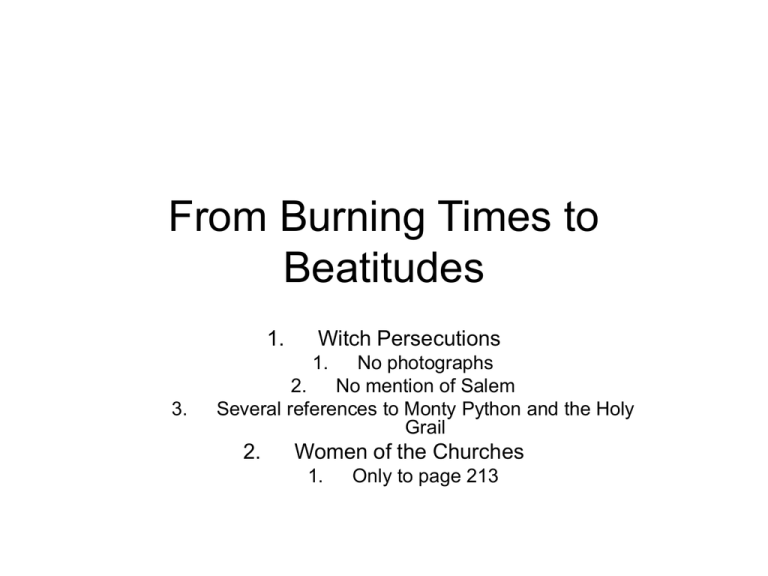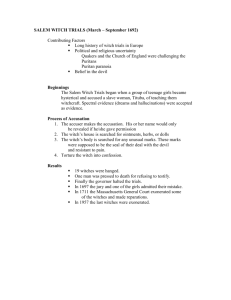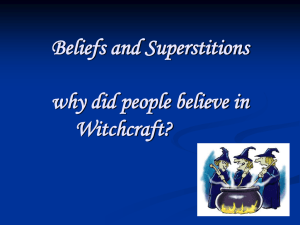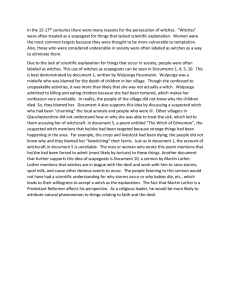From Burning Times to Beatitudes 1. Witch Persecutions
advertisement

From Burning Times to Beatitudes 1. Witch Persecutions 1. 3. No photographs 2. No mention of Salem Several references to Monty Python and the Holy Grail 2. Women of the Churches 1. Only to page 213 Joan of Arc • An extraordinary story for many reasons: – Young peasant girl does good and meets the Dauphin – lives among military men yet maintained her virginity and none contradicted – Successful strategist and inspiration on the battlegrounds Joan of Arc • Her story is also extraordinary because we know it intimately – her trial and the witnesses’ testimony tell us much about peasant life in France in the 15th century • She was born in 1412, a trying time for France as the English had occupied important strongholds of France since 1380 • Her crime, summarizing the twelve articles, was heresy and she died for it Was she considered a witch? • Joan of Arc was not typical in so many ways but that includes her trial and burning for heresy • She is much more likened to her own Saints Catherine and Margaret – a martyr (who became a Saint in 1920) • She was not a part of the witch hunt – that came a bit later with the publication of Malleus Malificarum A long line of witches • “Where there are many women there are many witches” (165) • Malleus Malificarum is published about one hundred years before the widespread persecution • No scholar has been able to explain the phenomenon of witch persecutions that began in the late 16th and early 17th century (W. Europe) and continued into the 18th century (E. Europe) Issue of authority? • According to the writings of the churchmen men in positions of power and authority in the Church and the state encouraged the first accusations and were the most zealous in hunting down the evil ones (167) • Witches became part of purges and expulsion of Jews, Protestants, lapsed Catholics, the poor, etc. They were not always the only reason, they often provided a vehicle for expulsion of “undesirable” groups A Woman’s Issue • Midwives, however, were often targeted: – The mystery of their knowledge of the birthing process – Translated to access infants for the Black Mass • Often, the accusation of one woman led to many other accusations Not trial by ordeal – torture was more “just” and “legal” • Trial by ordeal left it to God • During this period – “law” and “science” were used – Law including torture – Science including astrology and alchemy • Church courts followed strict rules of procedure but still knew that “things go bump in the night” The strapado A shift in focus • By the beginning the 17th century, the focus shifted: – Rather than calling them heretics united with the Devil, they were “possessed”, unwilling souls in need of exorcism and prayer, not execution – False accusations brought fines – By 1613, even the Spanish Inquisition said the confessions had gone too far and absolved over 1000 people in the Logrono region of Spain Remnants of the Peasant Woman’s World What role does the Church play? • For some, opportunity • Hrotsvit of Gandersheim (930-990) used her position as abbess to write legends of exemplary saints and plays to counter images of weak corruptible women Another learned woman • Herrad of Landsberg in Alsace • With her community of sixty nuns they produced the Hortus deliciarum (The Garden of Delights) Hildegard of Bingen 1098-1179 • Few matched her intelligence in science and herb medicine, music, literature and art • She also represents the cusp, the joint between the early Christian women who challenged sex roles and the coming of the centralized Church Rise of Universities • These became male domains, women in the Church lost authority through loss of land and office, but also learning • Thomas Aquinas – women had no power of grace in them Aquinas – bit of a jerk The Woman who would be Pope • Like Greek comedians before him, Steven of Bourbon wrote a cautionary tale of a woman, dressed as a man, who became Pope, but then her lust for a young man did her in – she died in childbirth Class Issues • Women of higher class could still get into the higher orders of the church • Nuns, sequestered, cloistered; even here she looks a bit fuzzy and imprisoned A Love Story-with castration Heloise and Abelard – her reputation stayed remarkably intact despite the child Astralabe The Orders • Benedictine, Augustinian, (older) Cistercian, Cluniac and Carmelite (newer) orders all accepted women’s communities begrudgingly • Franciscan and Dominican were least likely to accept “sorority” establishments • Fourth Lateran Council of 1215 forbade any more orders, so women had to join what was available Benedictine nuns – a life unchanged over hundreds of years Mystics • Helfta community of mystics including: • Mechthild, Gertrude and Mechthild (seen here in 1258): • Wealthy, pious, learned • Mystics have a direct relationship with God, usually coming through meditation and prayer, rather than books





